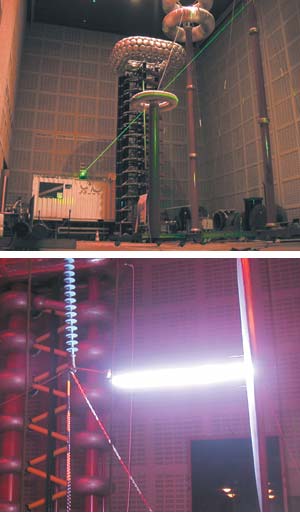April 20, 2005
Stealing Celestial Fire
An interesting bit of research on how to trigger lightning on demand. The article is in IEEE Spectrum and deals with lab experiments using an ultra-short pulse of laser light to ionize air molecules to the point where they can trigger a lightning stroke.Stealing Celestial FireHere is a photo of the equipment in operation:
A laser has sparked artificial lightning in a laboratory, a first step toward controlling real thunderbolts
There has to be a better way of tapping a lightning bolt than flying a kite in a storm, and a group of French and German scientists just may have found one. They have demonstrated in a laboratory that shining powerful laser pulses between two electrodes elicits a controllable form of lightning. They hope that their invention will eventually help to fend off lightning strikes on airports and power stations.
They employed their Teramobile laser, whose pulse lasts for a mere 100 femtoseconds and packs a peak power of 5 terawatts. The pulse rips the electrons from air molecules, creating a plasma; it also changes the refractive index of the air, a phenomenon called the Kerr effect. The effect focuses the light just enough to balance plasma-induced diffraction, creating a straight and highly conductive channel, called a filament, which can stretch up to 3.8 meters between the charged electrodes.
In the experiment, a 1- to 2-megavolt electrode simulates a thundercloud and an electrically grounded plate simulates the earth. The laser-induced filaments short-circuit the electrodes, triggering an electric discharge much like a lightning bolt. To complete the simulation, the researchers sprayed water between the electrodes. "We expected that the 'rainwater' would scatter light and perturb the filaments, but the filaments survived the interaction," says Jérôme Kasparian, a lead investigator and a member of the group from the University of Lyon, in France. Another team hails from the École Polytechnique, in Palaiseau, France; two others come from the Free University of Berlin and the Friedrich Schiller University, in Jena, Germany.

Posted by DaveH at April 20, 2005 9:38 PM
Comments
Post a comment